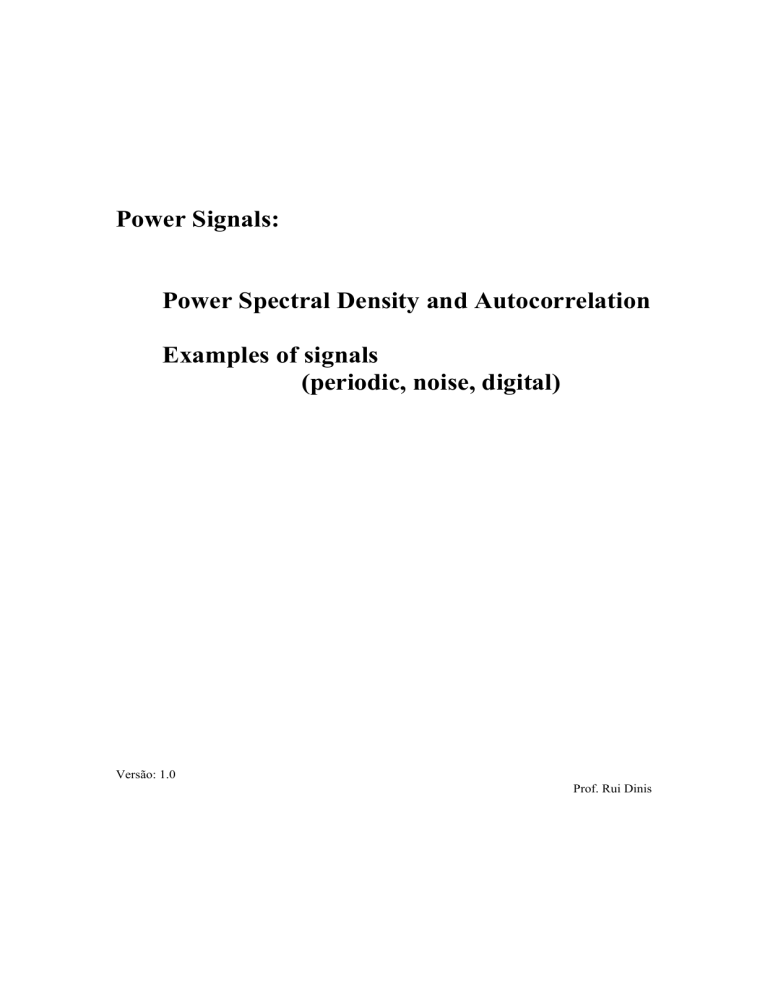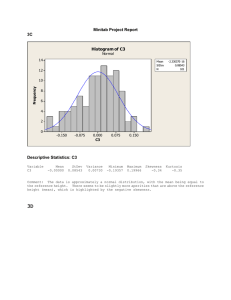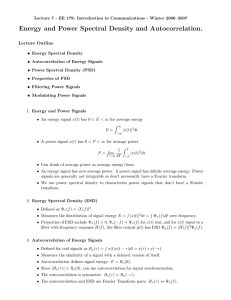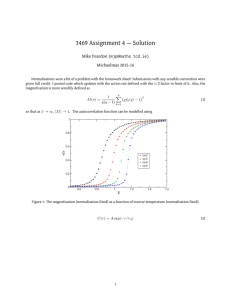Power Signals: Power Spectral Density and Autocorrelation

Versão: 1.0
Power Signals:
Power Spectral Density and Autocorrelation
Examples of signals
Prof. Rui Dinis
1.
Preamble
It was shown that the energy of a signal ( ) is
E x
= ∫
+∞
−∞ x t
2 dt its autocorrelation is given by
R x
= ∫
+∞
−∞
( ) ( − τ ) dt and the corresponding energy spectral density is
Ψ x
( ) | ( ) | 2
(2)
The energy, energy spectral density and autocorrelation function of energy signals are related and have the following properties:
P1.
E x
+∞
= Ψ
−∞
∫ x
This can be seen considering (3) and the Rayleigh theorem.
P2.
E x
=
R x
(0)
This can be seen considering τ = 0 in (2)
P3.
The energy in the band [f1, f2] is given by
P4.
P5.
f
2
∫ f
1
Ψ x
Ψ x
= F {
R x
} = ∫
+∞
−∞
R x
τ − j
2 π )
R x
= F − 1
{ Ψ x
}
+∞
= Ψ
−∞
∫ x j
π ft dt
The energy spectral density and autocorrelation are Fourier transform pairs
P6.
|
R x
τ ≤
R x
(0)
The autocorrelation has a maximum (possibly a local one) at τ = 0.
2
P7.
Ψ x
( ) 0
This can be seen considering (3)
P8.
R x
τ
R
* x
This comes from (2) and means that the real part of the autocorrelation is symmetric
and the argument part of the autocorrelation is antisymmetric .
P9.
For real signals
R x
τ
R x
and x
( f
) = Ψ x
The part of the autocorrelation comes from P8. The part of the energy spectral density comes from the fact that the amplitude spectrum |G(f)| of a real signal g(t)
is an even function of the frequency f
, and from (3).
P10.
If ( ) h t
and frequency response ( ) then the resulting signal ( ) = ( )* ( ) has energy spectral density
Ψ y
= Ψ x f H f
2 and autocorrelation
R y
=
R x
τ h t h
− t
Please, consult the recommended book for the explanation of P10.
2.
Power Signals
2.1. Power Spectral Density and Autocorrelation
Clearly, the energy spectral density and autocorrelation function of energy signals are important tools for the characterization of energy signals. The other important class of signals we will study are the power signals
. Power signals are infinite in time – they remain finite as time t approaches infinity – and so, their energy is infinite (see eq.
(1)).
Power signals are very important in telecommunications, since they include:
• Periodic signals
• Channel white noise
3
• Most transmitted digital or analog signals (they are approximated as power signals, and they can be considered infinite, since their duration is in general much longer than the inverse of the bandwidth).
Therefore, it is desirable to have a counter-part of the energy spectral density and autocorrelation function of energy signals for power signals. They are called power spectral density (PSD) and autocorrelation function of power signals .
In the time domain we define average power
as
P x
=
T
0 lim
→+∞
1
2 T
0
+
T
0
∫
−
T
0 x t
2 dt , which is finite but non-zero.
In the frequency domain (the calculation of the average power using functions of frequency) the description of the power might not be possible because the signal is infinite and may not have Fourier transform.
The simplest way to define the PSD is by assuming that our infinite duration signal is the limit of a proper finite-duration signal, i.e.,
( ) =
T
0 lim
→+∞ x
T
0 t with x
T
0
( ) given by x
( )
T
0
⎧
⎩
( ), | | <
T
0
0, otherwise
So, the equation above for the average power becomes
P x
=
T
0 lim
→+∞
1
2
T
0
∫
+∞
−∞
( )
2 x t dt
T
0
.
From the Rayleigh theorem
∫
+∞
−∞
( )
2 x t dt
T
0
= ∫
+∞
−∞
( )
2
X f df
T
0
, with
X
( )
T
0
= ∫
+∞
−∞ x
T
0
( ) exp( − j
2 π ft dt denoting the Fourier transform of x
( ) . Note that
T
0 x
( ) is finite and has Fourier
T
0 transform. Now, the average power can be written in terms of frequency by
P x
=
T
0 lim
→+∞
1
2
T
0
∫
+∞
−∞
( )
2
X f df
T
0
.
4
The convergence of the integral allows us to include the limit inside the integrand
(interchanging the order of the operations limiting and integration), and therefore, the
PSD of ( ) is given by
S x
( ) =
T
0 lim
→+∞
1
2
T
0
|
X
T
0
( ) | 2 .
In general, the energy of the signal x
( ) associated to a power signal grows
T
0 approximately linearly with
T
0
. Therefore, the limit associated to the PSD exists and is finite. However, this approach for computing the PSD has two difficulties:
• For most power signals it is difficult to obtain X
T
0
( ) and/or the limit associated to the PSD. This is especially true for random power signals.
• The limit can be infinite for some power signals. For instance, if x
( ) =
A
T
0 then
X
T
0
( ) =
AT
0 sinc( fT
0
)
S x
= +∞ .
To overcome these difficulties, we can define an autocorrelation function of power signals, and relate it with the PSD, as it was done for energy signals. Essentially, we can define the PSD of ( ) as
S x
( ) = ∫
+∞
−∞
R x
τ − j
2 π ) ,
τ denotes the autocorrelation of ( ) , defined as
R x
τ =
T
0 lim
→+∞
1
2
T
0
T
0
∫
−
T
0
( ) ( − τ ) dt
.
This means that the PSD of ( ) is the Fourier transform of its autocorrelation.
The average power of ( ) is
P x
= ∫
+∞
−∞
S x
( )
From the autocorrelation definition we can also state
P x
=
R x
(0)
We can also define cross-correlations and cross spectra in the same way as they were defined for energy signals.
The average power, PSD and autocorrelation have the following properties (they are very similar to the properties of the energy spectral density listed in the preamble, and similar remarks for each one apply):
5
P1.
P2.
P3.
P4.
P5.
P6.
P x
= ∫
+∞
−∞
S x
( )
P x
=
R x
(0)
The power of the signal associated to the band [ f
1
, f
2
] is given by f
2
∫ f
1
S
( ) x
S x
( ) = F {
R x
} = ∫
+∞
−∞
R x
τ − j 2 π )
R x
= F − 1
{
S
( ) x
} = ∫
+∞
−∞
S x
( ) exp( 2 π )
|
R x
τ ≤
R x
(0)
P7.
P8.
S
( ) 0 x
R x
τ
R
* x
For real signals R x
τ
P9.
R x
S
− f ) =
S x f
P10.
If ( ) h t
and frequency response ( ) then the resulting signal ( ) = ( )* ( ) has PSD
S y
( ) =
S x
( ) | ( ) | 2 and autocorrelation
R y
=
R x
τ h t h
− t
2.2 Examples of signals
2.2.1 Periodic Signals
For the case of periodic signals with period
T
the integrals associated to the average power and autocorrelation can be restricted to a single period, i.e.,
P x
=
1
T
∫
T
0 x t
2 dt and
R x
=
1
T
∫
T
0
( ) ( − τ ) dt
6
Example 1: Sinusoidal and Complex Exponentials
For a sinusoidal signal with frequency f c
= 1/ T c
of the form
( ) =
A cos(2 π f t c
+ θ ) we have
R x
A
2
=
2 T c
∫
0
T c
=
A
2
T c
∫
0
T c cos(2 π f t c
+ θ ) cos(2 π f t c
τ θ ) dt
=
( cos(2 π τ c
+ π f c
(2 t
τ θ ) dt
=
A
2
2 cos(2 π τ c
)
The last equality comes from the following facts:
• cos(2 π τ c
) term is constant ( τ is independent, the integral is over t
).
• cos(2 π f c
(2 t
τ θ has period
T c
/2 and we are integrating it over two periods, which means that the corresponding integral is zero.
The corresponding PSD is
S
( ) x
= F {
R x
} =
A
2
4
δ ( f
− f c
) +
A
2
δ (
4 f
+ f c
) and its average power is
P x
= ∫
+∞
−∞
S x
( ) =
R x
(0) =
A
2
2
Note that the PSD, autocorrelation and average power are always independent of θ .
For the trivial case where the signal is constant (zero frequency and phase) of the form
( ) =
A
(
A
can be complex), we have
R x
τ =
A
2
S
( ) x
= F {
R x
τ } = | | 2 δ f
P x
= ∫
+∞
−∞
S x
( ) =
R x
=
A
2
For a complex exponential of the form x t
=
A j
π f t c
) we have
7
R x
=
1
T c
∫
0
T c
( ) ( − τ ) dt
=
A
2
T c
∫
0
T c exp( 2 π τ c
) dt
=
A j
π τ c
) where the last equality comes from the fact that the integrand is independent ( τ ). The corresponding PSD is
S x
( ) = F {
R x
τ } = | | 2 δ ( f
− f c
) and its average power is
P x
= ∫
+∞
−∞
S x
( ) =
R x
=
A
2 .
Example 2: Periodic Signals
Let us consider now a periodic signal with period
T
. This signal can be expanded as a
Fourier series in the form
=
+∞
∑ n
=−∞ x n exp( 2 π / ) , with the Fourier coefficients x n
=
1
T
∫
T
( ) exp( − j
2 π nt T dt
.
Therefore, its autocorrelation is the sum of the autocorrelation of the different exponential components. I.e., we have
R x
=
1
T
∫
T
0
( ) ( − τ ) dt
= n
+∞
∑
=−∞
| x n j
π nt T
.
The corresponding PSD is
S
( ) x
=
+∞
∑ n
=−∞
| x n
| 2 δ f
− n
T and its average power can be obtained by any of the following formulas:
P x
=
=
=
1
T
∫
T
0 x t
2 dt
∫
+∞
−∞
S
( ) x
+∞
∑ n
=−∞
| x n
| 2
8
2.2.2 White Noise and Filtered Noise
The noise is omnipresent in communication systems. There are several noise sources, but the most important is usually the thermal noise that is the result of the thermal agitation of particles. Although the detailed study of the noise characteristics is beyond the scope of this text, we will show how one can obtain the average power,
PSD and autocorrelation of white noise and filtered noise.
The noise at the receiver input is usually denoted by AWGN (Additive White
Gaussian Noise) and is modelled as a zero-mean Gaussian component that is added to the received signal component. In the following the AWGN will be denoted by ( ) .
The term “white” means that the power is evenly spread by all frequencies (as the white light that have all colours with the same relative power). Its PSD is usually denoted by
S w
( ) =
N
2
0 . where N
0
= kT , with k = denoting the Boltzmann’s constant and T the temperature, measured in Kelvin. This is in accordance with the thermodynamics result that the thermal noise power in a bandwidth Δ f is P
Δ f
= kT f (the ½ factor in the equation above results from the fact that we are considering positive and negative frequencies, while in thermodynamics only positive frequencies are considered).
This signal has autocorrelation
R x
= F − 1
{
S x
( )
} =
N
0
2
, and its average power (which can be obtained either by integrating the PSD, or from the autocorrelation at the origin) is clearly infinite (the bandwidth of white noise is infinite).
In practice the noise has finite power, since its bandwidth is not infinite. It only needs to be much higher than the bandwidth of the communication signals. The AWGN model is reasonable and simplifies the mathematical analysis of communication systems in the presence of noise.
The power of the white noise, ( ) , can be reduced by filtering it using a filter with impulse response ( ) H f . The resulting signal
ν ( ) = ( )* ( ) , has PSD
S
ν
( ) =
S x
( ) | ( ) | 2 =
N
0
2
9
H f
2
and autocorrelation
R
ν
=
R w
τ h
τ h
N
0
2 h
τ h
− τ .
The corresponding average power can be obtained by any of the following formulas:
P
ν
=
=
=
= ∫
+∞
−∞
S
ν
( )
N
0
2
N
0
2
∫
+∞
−∞
∫
+∞
−∞
R
ν
(0)
H f
2 df h t
2 dt
2.2.3. PAM Signals
The signals employed in digital communications are usually pulses. They can have the same amplitude, or the amplitude can be the result of a modulation process. The latter case is more general for our example and it is called PAM (Pulse Amplitude
Modulation). A general expression for these pulses that can vary in amplitude is
= ∑ k k
( − kT
) . where r(t)
is the pulse shape and a
is the amplitude related to the value of the k symbol k
. For instance, if we consider binary communication the symbol is a bit. a might be
A
Volt for “1” and
–A
Volt for “0”; or k a
might be
0
Volt for “0” and
A k
Volt for “1”. As the sequence of pulses is not fixed (it depends on the message of the communication) we can consider that PAM signals are random power signals based on the pulse shape r ( t ) and the random sequence . Although, a detailed characterization of these signals is beyond the scope of this text, it can be shown that when the amplitudes a
are uncorrelated and equally distributed then the PSD of the k
PAM signal is
S
( ) x
=
1
T
=
1
T a
2 k
− ( ) k
2 ( ) +
T
2
2
∑ n
P
δ a
2 k
− ( ) k
2 ( )
2 +
( ) 2
T
2
∑ n
R
⎛ ⎞
⎝ ⎠
2
δ
⎛
⎝ f f
−
T
− n
=
T n where ( ) | ( ) | 2 , with = F { }
denoting the Fourier transform of the support pulse. The corresponding autocorrelation is
10
with
R x
= F − 1
{
S x
( )
} =
T
1
= F − 1
{
P f
} = r t r
− t a
2 k
− a k
2 p
τ +
1
T a k
.
2
∑ n p ( τ − nT ) ,
If a k
= 0 (this is the case, for instance, when a k
=
A
and a k
= −
A
for “1” and “0”, and both bits occur with equal probability. There are other very different cases for which a k
= 0 ), then
S x
( ) =
1
T a
2 k
| ( ) | 2 and
R x
= F − 1
{
S
( ) x
} =
T
1 k
.
Assuming the assumptions above we can see that the bandwidth of a PAM signal is equal to the bandwidth of its pulse shape. So, if we want a bandlimited digital transmission we just need to select a bandlimited pulse shape.
11



